check engine AUDI A8 2011 User Guide
[x] Cancel search | Manufacturer: AUDI, Model Year: 2011, Model line: A8, Model: AUDI A8 2011Pages: 302, PDF Size: 76.07 MB
Page 74 of 302
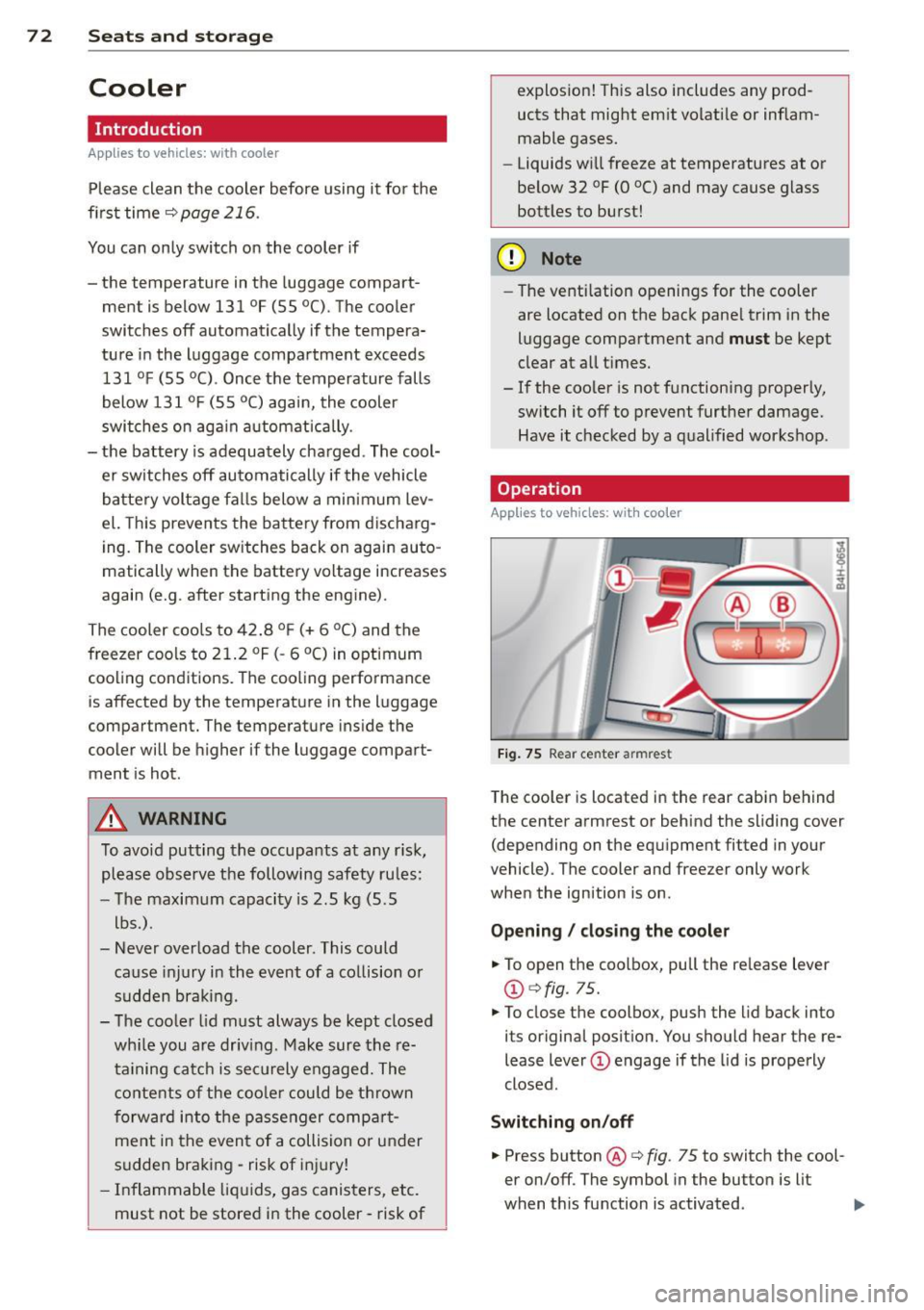
7 2 Seats and st o ra ge
Cooler
Introduction
Applies to vehicles: with cooler
Please clean the cooler before using it for the
first time~
page 216.
You can only switch on the cooler if
- the temperature in the luggage compart
ment is below 131 °F (55 °C). The cooler
switches off automatically if the tempera
ture in the luggage compartment exceeds 131 °F (55 °C) . Once the temperature falls
below 131 °F (55 °C) again, the cooler
swit ches on aga in automatically.
- the battery is adequately charged. The cool
er switches off automatically if the vehicle
ba ttery voltage fal ls below a minimum lev
el. This prevents the battery from d ischarg
i ng. The cooler switches back on again auto
matically when the battery voltage increases
again (e.g. after starting the engine).
The cooler coo ls to 42 .8
° F ( + 6 °c) and the
freezer cools to 2 1.2 °F (- 6 °C) in optimum
cooling cond itions. The cooling performance
is affected by the temperature in the luggage
compartment. The temperature inside the
cooler will be higher if the luggage compart
ment is hot.
.,&. WARNING
To avoid putting the occupa nts at any r isk,
please observe the following safety ru les:
- The maximum capacity is 2.5 kg (5 .5
lbs.).
- Never overload the cooler. This could cause injury in the event of a co llision o r
s u dden bra king.
- The coo le r li d must always be kept closed
wh ile you are driv ing. Make sure the re
taining catch is sec urely engaged . The
c o ntents of the coo le r could be thrown
forwar d into the passe nger comp art
ment in the event of a collision or u nder
s udden braking -risk of inj ury!
- Inflammable liq uids, g as canisters, etc.
must not be store d in the cooler -risk of explos
ion! This also includes any prod
ucts that might em it volati le or inflam
mable gases.
- Liquids w ill freeze at temperatures at or
be low 32 °F (0 °C) and may cause glass
bottles to burst!
(D Note
- The venti lation openings for the cooler
are located on the back pane l trim in the
luggage compartment and
must be kept
clear at a ll times.
- If the coo ler is not functioning properly,
switch it off to prevent furt her damage.
Have it checked by a qualified works hop.
Operation
Applies to vehicles: with coo ler
Fig. 75 Rear center armrest
The cooler is located in the rear cabi n behind
the center armrest or behind the sliding cover
(depending on the equipment fitted in your
vehicle). The cooler and freezer only work
when the ignition is on .
Opening / clos ing the co oler
.,. To open the coolbox, pull the re lease lever
@ qfig. 75.
.,. To close the coolbox, push the lid back into
its original position. You should hear the re
lease lever
(D engage if the lid is properly
closed.
Switching on /off
.,. Press button @ q fig. 75 to switch the cool
er on/off. The symbol in the button is lit
when t his function is activated. .,,_
Page 194 of 302
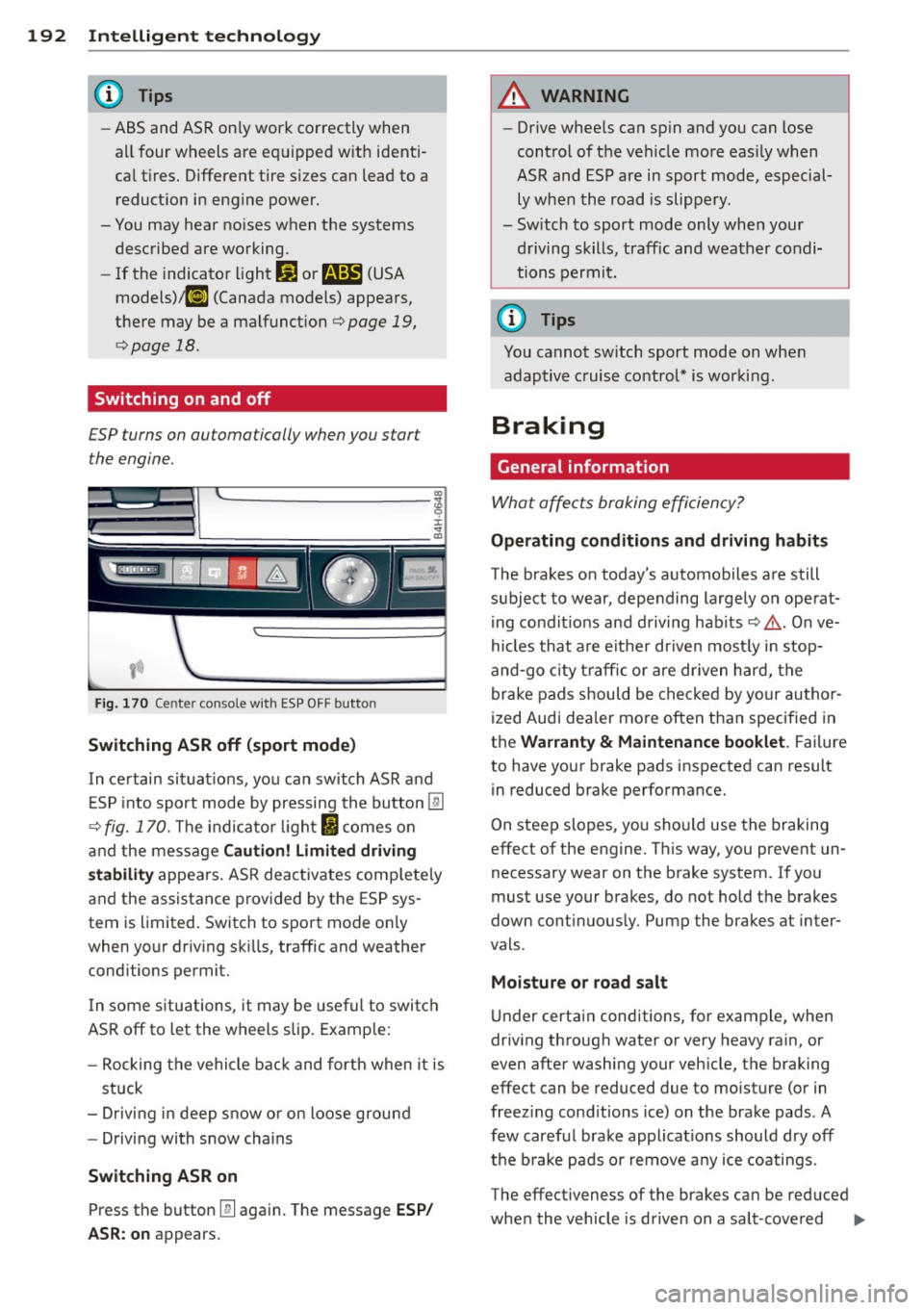
192 Intelligent technology
-ABS and ASR on ly work correctly when
a ll four wh eels are eq uipped w ith ident i
ca l tires. Different tire s iz es can lead to a
reduct ion in engine power.
- You may hear no ises when the systems
described are working.
- If the indicator light
DJ or m (USA
models) ;tl] (Canada models) appea rs,
there may be a malfunct ion
c::;, page 19,
c::;, page
18 .
Switching on and off
ESP turns on au toma tically when you s tar t
the engine .
Fig . 170 Cen ter con sole w it h ESP OF F button
Switching ASR off (sport mode)
In ce rtain situat io ns, yo u can switch ASR and
E SP into sport mode by pressing the button
l!I
c::;, fig. 170. The indicato r light fl comes on
and the mess age
C aution! Limit ed driving
s tability
appears . ASR deact ivates comp lete ly
and the assistance prov ided by the ESP sys
tem is limited. Switch to sport mod e onl y
when your d riv ing sk ills, traffic and weather
conditions permit.
In some situations, it may be useful to switc h
ASR off to let the wh eels slip. Example:
- Rocking the vehicle bac k and forth when it is
stuck
- Driv ing in deep snow or on loose ground
- Driving with snow cha ins
Sw itching ASR on
Press the button I!] aga in. The message ESP /
ASR: on appears .
A WARNING
-Drive whee ls can sp in and you can lose
control of the vehicle more eas ily when
ASR and ESP are in sport mode, especial
ly whe n the road is slippery .
- Sw itch to sport mode only when your
d riving skills, traff ic and weather condi
tions perm it.
@ Tips
You cannot sw itch sport mode on whe n
adaptive c ruise co ntrol* is worki ng.
Braking
General information
Wha t affe cts braking effi cien cy?
-
Operating conditions and driving habits
The brakes o n today's automobiles are still
s u bjec t to wear, depending largely on operat
ing cond it ions and driving hab its
c::;, &. . On ve
hicles that a re e it h er dr iven most ly in stop
and-go city t ra ffi c or are dr iven hard, the
brake pads should be checked by yo ur au thor
ized Audi dea ler mo re often than specified in
t h e
Warranty & Maintenance booklet. Failure
to have your brake pads inspected can result in reduced brake performance.
On steep slopes , you sho uld use the braking
effect of the engine. This way, you prevent un
necessary wear on the brake system . If you
must use your b rakes, do not hold t he brakes
down continuous ly. Pump the brakes at in ter
vals .
Moisture or road salt
U nd er certain conditions, for example, when
driving through water or very heavy rain, or
even after washing your veh icle, the braking
effect can be reduced due to moisture (or in
freez ing cond itions ice) on the brake pads . A
few caref ul brake applicat ions should dry off
t h e b rake pads or remove a ny ice coatings .
The effectiveness of the brakes ca n be reduced
when the vehicle is d riven on a sa lt-covered
ll>
Page 195 of 302

road and the brakes are not used. Here too,
you shou ld clean off accumu lated salt coating
from brake discs and pads with a few carefu l
applications of the brake
c> ,&. .
Cor rosion
There may be a tendency for dirt to build up
on the brake pads and corrosion to form on
the discs if the car is not driven regularly or
only for short trips with little use of the brakes.
If the brakes are not used frequently, or if cor rosion has formed on the discs, it is advisable
to clean off the pads and discs by brak ing
f irmly a few times from a moderately high
speed
c> &, .
Fau lts in th e bra ke s ystem
If you should notice a sudden increase in
brake peda l travel, then one of the two brake
ci rcu its may have failed
c> ,&. .
Low brak e fluid l evel
Malfunct ions can occur in the brake system if
the brake fluid level is too low. The brake fluid
leve l is monitored electronically.
Brake lining w ear statu s
Brake lining wear may be checked by visual in
spection of the condition of the brake pads
through the openings in the whee l. If neces
sary, the wheel may be removed for this in
spection
c> page 262, Changing a wheel .
8_ WARNING
-You should perform braking maneuvers
for the purpose of clean ing the brake
system on ly if road condit ions permit.
Other road users must not be put at r isk -
you may cause an acc ident!
- Before descending a steep grade, reduce
speed and shift transmiss ion into a lower
gear or lower driving range . Do not ride
the brakes or hold the pedal down too lo ng or too often. This cou ld cause the
brakes to get hot and dimin ish b raking
effi ciency.
Int ellig ent technolog y 193
-Do not "ride the brakes" by resting your
foot on the pedal when you do not intend
to brake. This may cause the brakes to
overheat, premature wear and increased
stopping distance .
- Under certain cl imatic and operat ing
conditions such as passing through wa
ter, dr iv ing in heavy rain or after washing
the vehicle, the effectiveness of the
b rakes can be reduced. In winte r, ice can
accumulate on the brake pads , lin ings,
discs and drums . Carefu lly app ly brakes
for a test . Brakes will dry and ice coat
ings wi ll be cleaned off after a few care
fu l brake applications.
- Driving for an extended period of time on
salt-covered roads without using your
brakes can a lso affect braking efficiency.
Clean off accumu lated salt coating from
brake discs and pads with a few careful
brake applications .
- If you damage the front spoiler, or if you
install a different spoiler, be sure the air
f low to the front brakes is not obstruct
ed. Otherw ise the brake system could
overheat reduc ing the effectiveness of
the entire brake system.
- Failure of one b rake circuit will impai r
the braking capab ility result ing in an in
creased stopping distance. Avoid driving
the vehicle and have it towed to the near
est A udi dealer or qualified workshop .
Brake booster
The brake booster adds extra braking power.
The brake booster works with vacuum pres
su re which is created only whe n the engine is
runn ing
c> &, .
A WARNING
-Never let the vehicle roll to a stop with
the engine shut off.
-
- If the b rake booster is no t working, for
examp le when towing you r vehicle, or
because the brake booster has somehow
Ill>
•
•
Page 196 of 302
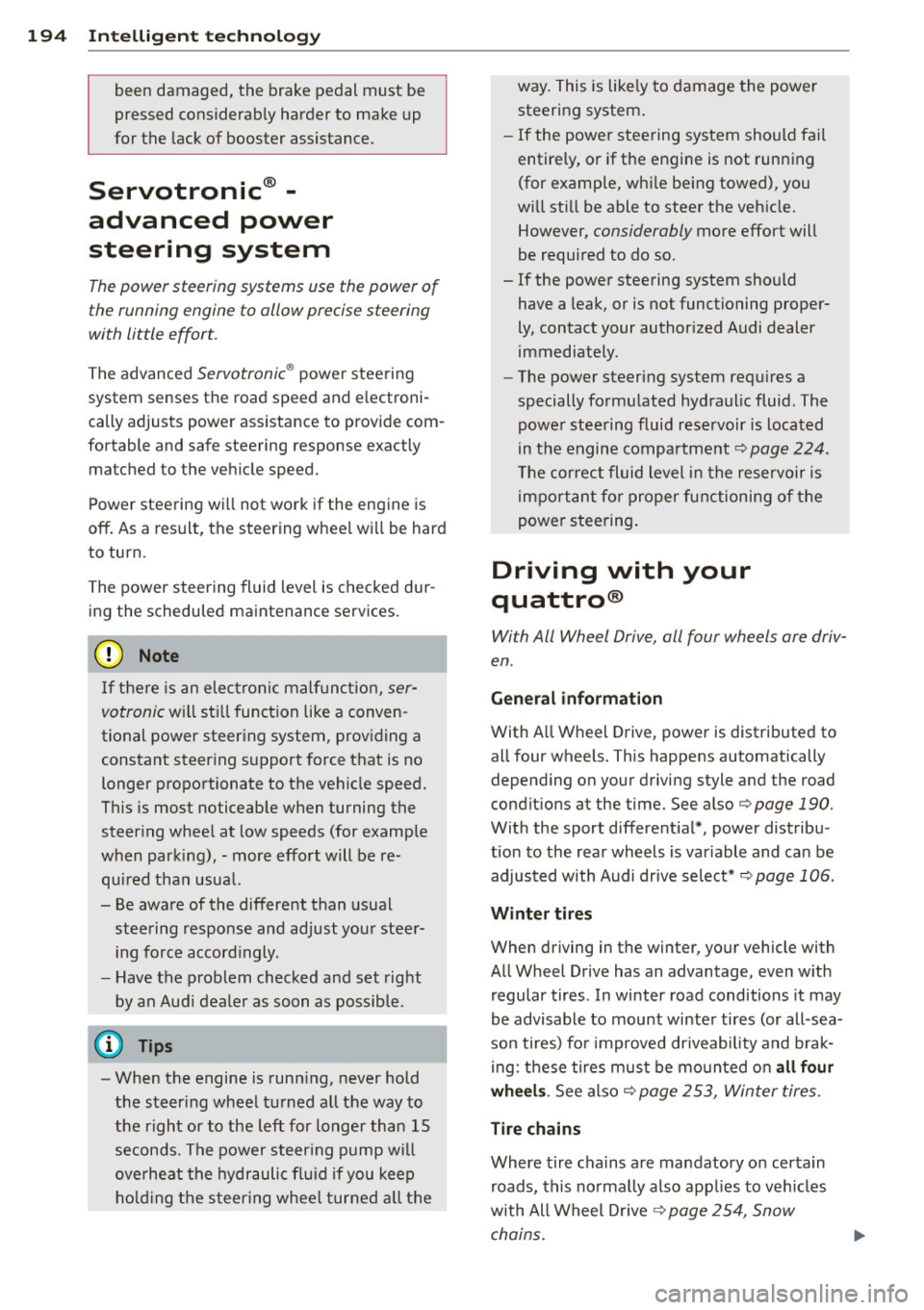
194 Intelligent technology
been damaged, the brake pedal must be
pressed considerably harder to make up
for the lack of booster assistance.
Servotronic ® -
advanced power
steering system
The power steering systems use the power of
the running engine to allow precise steering
with little effort .
The advanced Servotronic® power steering
system senses the road speed and e lectroni
cally adjusts power assistance to prov ide com
fortable and safe steering response exactly
matched to the veh icle speed.
Power steering w ill not work if the eng ine is
off . As a result, the steering whee l wi ll be hard
to turn.
The power steering fluid level is checked dur
ing the scheduled maintenance serv ices.
([) Note
If there is an electronic malfun ct ion, ser
votronic
w ill still f unction like a conven
tional power steer ing system, providing a
constant steering support force that is no
longer proportionate to the vehicle speed.
This is most noticeab le when turning the
steer ing whee l at low speeds (for examp le
when parking), - more effo rt will be re
qui red than usua l.
- Be aware of the different than usual
stee ring response and adjust yo ur stee r
i ng fo rce accord ingly.
- Have the p roblem checked and set rig ht
by an Aud i deale r as soon as possib le.
(D Tips
- When the engine is runn ing, never hold
t h e steer ing whee l turned all the way to
the right or to the left for longer than 15
se conds. The power steer ing p ump w ill
ove rhe at the hydr aulic flu id if you keep
ho ld ing the steering whee l turned all the way
. This is likely to damage the power
steering system .
- If the powe r steering system sho uld fai l
entirely, o r if the engine is not runn ing
(for examp le, whi le being towed), you
w ill sti ll be able to steer the veh icle.
However,
considerably more effort will
be required to do so.
- If the power steering system sho uld
have a leak, or is not functioning proper
ly, contact your author ized Audi dealer
immed iately.
- The power steering system requ ires a
specially fo rmu lated hydraulic fluid. The
powe r stee ring fluid reservoir is locat ed
in the engine compartment
Q page 224.
T he corre ct fl uid level i n the reservoir is
impo rta nt fo r proper fu nctioning of the
powe r stee ring .
Driving with your
quattro ®
With All Wheel Drive, all four wheels are driv
en .
Gen eral information
With A ll W heel Drive, power is distributed to
all four wheels. This happens automatically
depending on your driving style and the road
condit ions at the time. See also
Q page 190.
With the sport different ial*, powe r distribu
tion to the rear wheels is variable and can be
adjusted with Audi drive select*
Q page 106 .
Winter tires
When driving in the winter, yo ur vehicle with
All Wheel D rive has an advantage, even w ith
r egular tires . In wi nter road conditions it may
be advisable to mount winter tires (or all-sea
son tires) for improved driveability and brak
i ng : these tires must be mo unted o n
all four
wheel s. See also q page 253, Winter tires.
Tire chains
Where tire chains are mandatory on certa in
roads, this no rma lly also app lies to veh icles
with All Wheel D rive
q page 254, Snow
chains .
Page 201 of 302
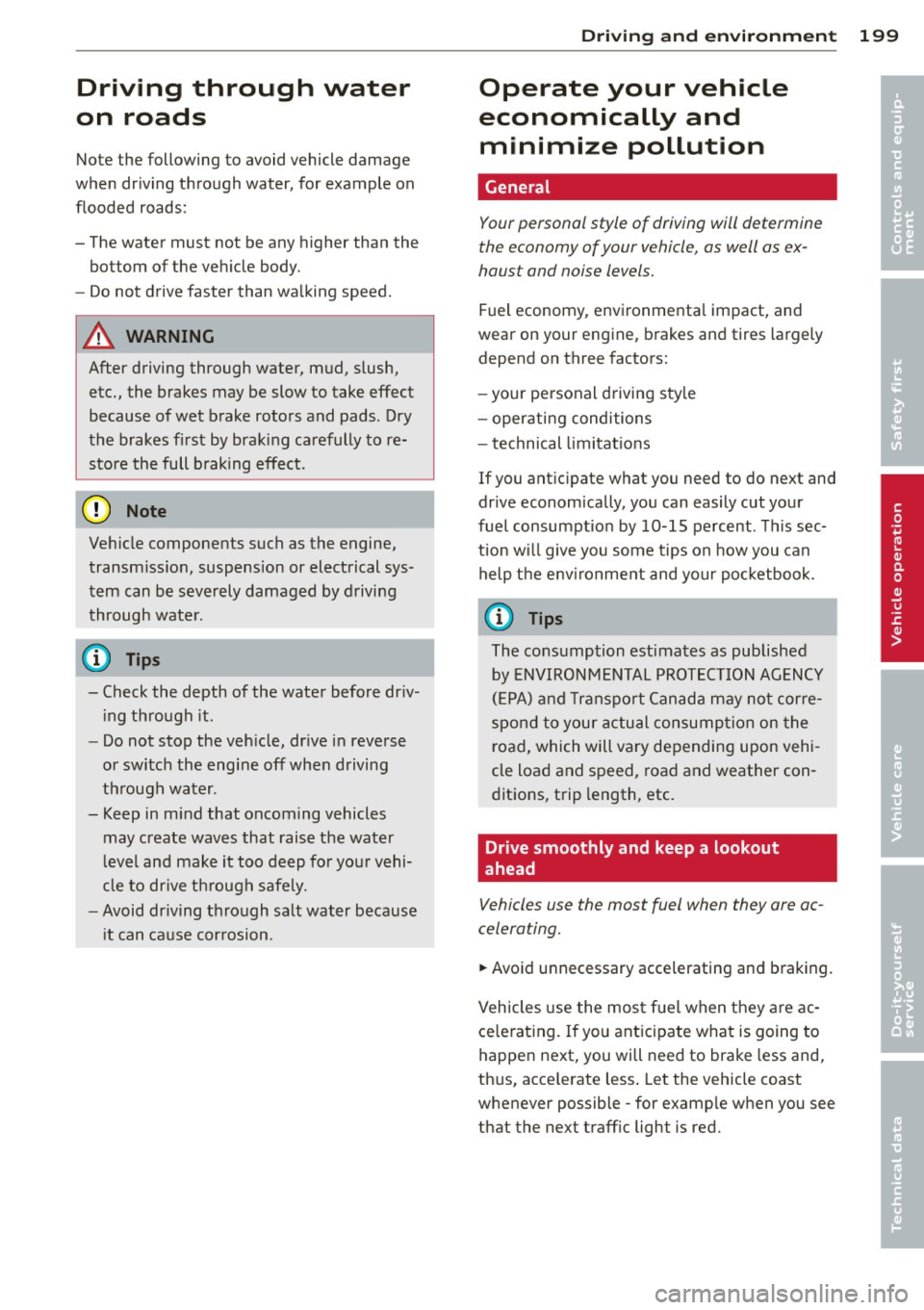
Driving through water
on roads
Note the following to avoid vehicle damage
when driving through water, for example on
flooded roads:
- The water must not be any higher than the
bottom of the vehicle body.
- Do not drive faster than wa lking speed.
A WARNING
After driving through water, mud, slush,
etc., the brakes may be slow to take effect
because of wet brake rotors and pads. Dry
the brakes first by braking carefully to re
store the full b raking effect.
([) Note
Vehicle components such as the engine,
transmiss ion, suspension or electrical sys
tem can be severely damaged by driving
through water.
- Check the depth of the water before dr iv
i ng through it.
- Do not stop the veh icle, drive in reverse
or switch the engine off when driving
through water .
- Keep in mind that oncoming vehicles
may create waves that raise the water
level and make it too deep for your vehi
cle to drive th rough safely.
- Avoid dr iving through sa lt water because
i t can cause corrosion.
Dri vin g and en vironm ent 199
Operate your vehicle
economically and
minimize pollution
General
Your personal style of driving will determine
the economy of your vehicle, as well as ex
haust and noise levels.
Fuel economy, environmenta l impact, and
wear on your eng ine, brakes and tires largely
depend on three factors:
- your personal d riving style
- operating conditions
- technical limitat ions
If you ant ic ipate what you need to do next and
drive economically, you can easily cut your
fuel consumpt ion by 10-15 percent . This sec
tion w ill give you some tips on how you can
help the environment and your pocketbook.
@ Tips
The consumption estimates as published by ENVIRONMENTAL PROTEC TION AGENCY
( E PA) and Tra nspo rt Canada may not corre
spond to your actual consump tion on the
road, which will vary depending upon vehi
cle load and speed, road and weather con
ditions, trip length, etc.
Drive smoothly and keep a lookout
ahead
Vehicles use the most fuel when they are ac
celerating.
.,. Avoid unnecessary accelerating and braking.
Vehicles use the most f uel when they are ac
ce le rating. If you ant icipate what is going to
happen next, you will need to brake less and,
thus, acce lerate less . Let the vehicle coast
whenever possible - for examp le when you see
that the next traff ic light is red.
•
•
Page 202 of 302

200 Driving and en vi ro nm ent
Avoid full throttle
Driving at moderate speeds saves fuel and
improves your mileage .
"'Try and keep well below your car 's maximum
speed.
Accelerating gently reduces fuel consump
tion, engine wear, and does not disturb the
environment. F ue l consumption, exhaust em issions and en
gine noise increase disproportionately at high
speeds. If you drive at approximately three
quarters of top speed, fue l consumption will
be reduced by one half. Never drive faster
than the posted speed limit and weather con
d itions permit .
Reducing unnecessary idling
Even when your car is just idling it burns up
fuel.
"'Shut the engine off when you are not driving
the vehicle .
"'Do not warm up the veh icle by letting the
engine run at idle .
It makes sense to shut
off the e ngine in traff ic
jams, when waiting for trains to pass at ra il
road crossings , or at traff ic lights that have
long wa its on red. Turning the engine
off fo r
just
30-40 seconds saves more fue l than is
burned s tarting the eng ine again .
It takes a long time for the engine to warm up
fully when it is running at idle . Howeve r, wear
and noxious em issions are especially high
when the engine is warming up. So you should
drive away as soon as you start the engine and
avoid running at high rpms while the engine is
still warming up .
([) Note
Do not leave engine idling unattended af
ter starting . If warning lights should come
on to indicate improper operation, they
wou ld go unheeded. Extended idling also
produces heat, which cou ld result in over- heating or other damage to the vehicle or
other property .
Regular maintenance
A badly tuned engine unnecessarily wastes a
lot of fuel.
"' Have your ve hicle serviced at reg ular inter -
vals.
By having your veh icle regu larly serviced by an
Audi dealer he lps to ensure that it runs p rop
erly and economically. The condition of your
vehicle not only affects its sa fety and ability to
hold its value, it also affects
fuel c onsump
tion .
Check your oil e ach time you fill your t ank .
The amount of oil used is related to engine
load and speed .
It is normal for the oil consumption of a new
engine to reach its lowest value after a certa in
mileage has been driven.
You must drive your veh icle about 3,000 m iles
(5,000 kilometers) before you can properly
assess oil consumpt ion.
This also app lies to fue l consumption and en
gine output.
(D Note
- Have your vehicle maintained proper ly
and in accordance with the service rec
ommendations in your Warranty
& Main
tenance booklet. Lack of proper ma inte
nance as well as improper use of the ve
hicle will impair the function of the
em iss ion contro l system and cou ld lead
to damage.
- Do not alter or remove any component of
the Emission Control Sys tem unless ap
proved by the manufacture r.
- Do not alte r or remove any device, such
as heat sh ie lds, switches, ign it ion w ires,
valves, which are designed to protec t
your vehicle's Emission Control System
and other impo rtant vehicle compo
nents .
Page 205 of 302
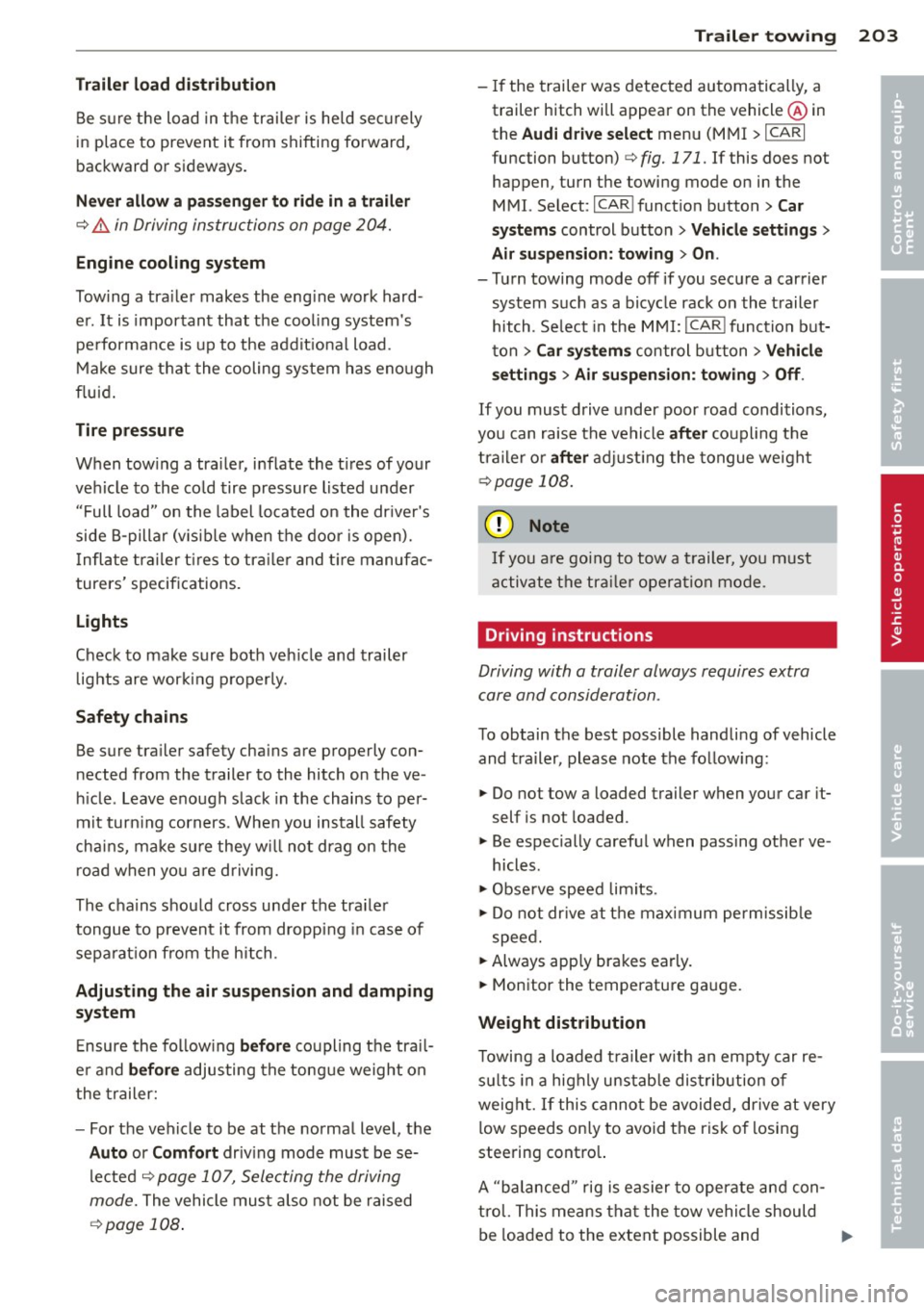
Trailer lo ad di stri bu tion
Be s ure the load in the trai ler is held securely
in place to prevent it from shifting forward,
backward or sideways.
N eve r allow a p assenger to rid e in a tr ailer
,=:, .&. in Driving instructions on page 204.
Engine cooling s ystem
Towing a tra iler makes the eng ine work hard
er . It is important that the cooling system's
pe rformance is up to the addit ional load .
Make sure that the cooling system has enough
fluid.
Tire p res sure
When tow ing a trailer, inflate the t ires of your
vehicle to the co ld tire pressure listed under
" Full load " on the label located on the dr iver's
side B-pillar (v is ible when the door is open).
I nflate trailer tires to tra iler and t ire manufac
turers' specifications.
Lights
Check to make sure both veh icle and trailer
lights are working properly .
Safety chain s
Be sure trailer safety cha ins are properly con
nected from the trailer to the hitch on the ve
h icle . Leave enough slack in the chains to per
mit turn ing corners . When you install safety
cha ins, make sure they w ill not drag on the
r oad when yo u are driving.
The chains should cross under the trailer
tongue to prevent it from dropping in case of
sepa rat ion from the hitch .
Adjusting the air su spens ion an d damping
s y stem
Ensure the follow ing b efore coupling the trai l
e r and
b efo re adjusting the tongue weight on
the trailer:
- For the veh icle to be at the normal level, the
A uto or Comfort driv ing mode must be se
lected
,=:, page 10 7, Selecting the driving
mode. The vehicle must a lso not be raised
,=:, page 108 .
Trailer to win g 203
-If the trailer was detected automatically, a
trailer hitch wi ll appear on the veh icl e@ in
the
Aud i dr ive se lect menu (MMI > ICARI
function button)
,=:, fig. 171. If this does no t
happen , turn the towing mode on in the
MMI. Select: I CAR I funct ion button>
C ar
sys tem s
control button > Vehicle setting s >
Air su sp en sion: t owing > O n.
- Turn towing mode off if you secure a carrier
system such as a bicycle rack on the trailer
hitch. Se lect in the M MI: ICAR !function but
ton >
Car syste m s control button > Vehi cle
se tting s
> Air su spen sion : towin g > Off.
If you must drive under poor road conditions,
you can raise the vehicle
aft er coupling the
tra iler or
aft er adjust ing the tongue we ight
,=:, page 108.
(D Note
If you a re going to tow a t railer, you must
activate the tra iler operation mode .
Driving instructions
Driving with a trailer always requires extra
care and consideration .
To obtain the best possible handling of vehicle and trailer, please note the follow ing :
.,. Do not tow a loaded trailer when your car it
self is no t loaded.
.,. Be especially careful when passing other ve
hicles .
.,. Obse rve speed limits .
.,. Do not dr ive at the max imum permissib le
speed.
.,. Always app ly brakes early .
.,. Monitor the temperature gauge.
Weight distribution
Towing a loaded t railer with an empty car re
s ul ts in a highly unstable distribution of
weight. If this cannot be avoided, dr ive at very
low speeds on ly to avoid the risk of losing
steering contro l.
A "balanced " rig is easier to operate and con
trol. This means tha t the tow vehicle should
be loaded to the extent possible and
IJI>
•
•
Page 218 of 302

216 Cleaning and protecti on
- To avoid damage, have stubborn stains
removed by a commercial cleaning spe
cialist.
- Do not use br ushes, stiff sponges or sim
ilarly abrasive cleaning aids.
Safety belts
Only well-maintained safety belts work relia
bly when needed .
> Keep belts clean.
> For cleaning, use a mild soap and wate r sol
ution . Let be lts dry thoroughly and away
from direct sunlight .
> Do not allow inertia reel safety be lts to re
tract before they are completely dry.
> Check the condition of your safety belts reg
ularly .
Heavily soiled safety belts may not retract
properly.
.&_ WARNING
Damaged safety belts can break in a crash.
- Anything that might damage your safety
belts could mean that you and your pas
sengers would not be adequately pro
tected in an acc ident.
- Safety belt performance depends on cor
rect installation. Never remove belts
from the vehicle to clean them.
- Do not use chemical cleani ng agents,
bleach or dyes. They have corrosive prop
ert ies which weaken the webbi ng.
- When cleani ng your safety belts, inspect
them for damage.
If you discove r dam
age, see you r A udi dealer.
- Always read and heed all WARNI NGS and
other information
c:> page 206.
Cooler
A ppl ies to vehicles: with cooler
A layer of ice or frost in the cooler interferes
with its cooling performance .
Clean ing
The refr igerator sho uld be cleaned reg ularly.
> Wash the coo ler with lukewarm wate r and a
mild cleaning solution, if necessary.
> Then wipe the cooler dry.
> Dust and d irt will accumulate near the venti
lation openings in the luggage compart
ment due to normal cooler usage. This
should be cleaned regularly.
D ef rosting
> Switch the coo ler off c:> page 72.
> Remove any food or beverages and allow the
coo ler to defrost with the door open.
> W ipe the inside of the cooler dry and clea n
the cooler, if necessary .
Defrost the cooler if you will not be us ing it
for extended periods of time .
(D Note
- Do not try to speed up the defrosting
process by apply ing heat.
- To reduce the risk of persona l injury or
damage to the refr igerator,
- do not use any abrasive cleaners, sol
vents, wax, agg ress ive clean ing solu
tions, solut io ns w it h strong frag rances,
etc.,
- d o no t clean the co oler w ith cleaning
tools su ch as s teel woo l.
Engine compartment
Be especially careful when cleaning the en
gine comportment.
Alway s switch off the ignit ion b efor e cle an
ing the engine
c:> ,&. .
Plenum panel
Remove leaves from the plenum panel in front
of the w indshield under the eng ine compart
ment . This prevents the wate r drain holes
from becom ing b locked, and it preve nts de
br is from entering the vehicle inte rior through
the heat ing and ven tilat ion duc ts.
Corrosion protection
The eng ine compartment and transmission
have been corrosion-protected at the factory .
ll-
Page 224 of 302
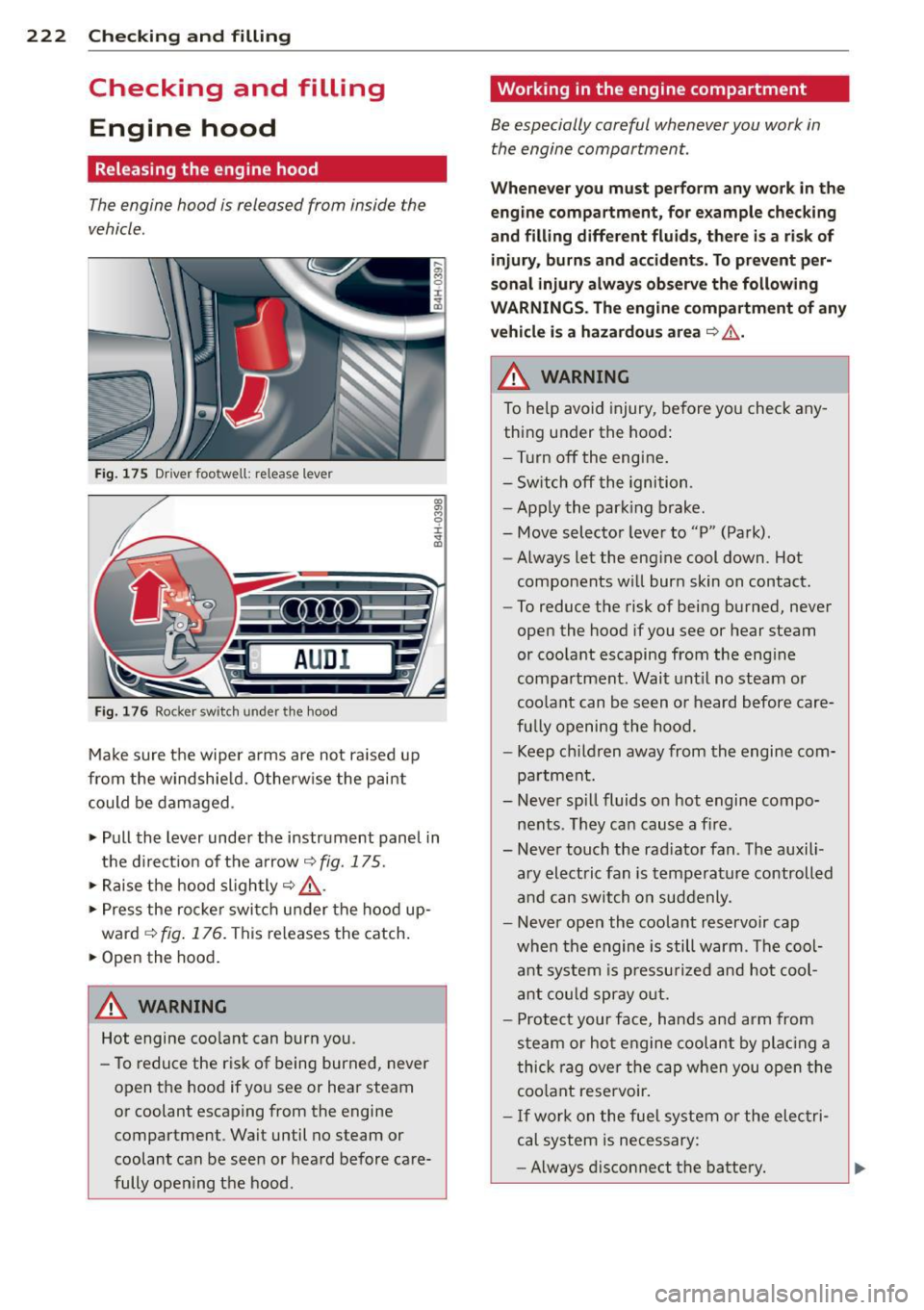
222 Checking and filling
Checking and filling Engine hood
Releasing the engine hood
The engine hood is released from inside the
vehicle .
Fig. 175 Driver foo twell: release lever
AUD I
Fig. 176 Rocker switch un der the hood
Make sure the wiper arms are not raised up
from the windshield. Otherwise the paint
could be damaged.
.,. Pull the lever under the instrument panel in
the direction of the arrow
¢ fig. 175.
.,. Raise the hood slightly¢,&. .
... Press the rocker switch under the hood up
ward ~
fig. 176. This releases the catch.
... Open the hood.
&_ WARNING
Hot engine coolant can burn you.
- To reduce the risk of being burned, never
open the hood if you see or hear steam
or coolant escaping from the engine compartment . Wait until no steam or
coolant can be seen or heard before care
fully opening the hood .
' Working in the engine compartment
Be especially careful whenever you work in
the engine compartment.
Whenever you must perform any work in the
engine compartment, for example checking
and filling different fluids, there is a risk of injury, burns and accidents. To prevent per
sonal injury always observe the following
WARNINGS. The engine compartment of any
vehicle is a hazardous area
¢ ,&. .
/n.. WARNING
To help avoid injury, before you check any
thing under the hood:
- Turn off the engine.
- Switch off the ignition .
- Apply the parking brake.
- Move selector lever to "P" (Park) .
- Always let the engine cool down. Hot
components will burn skin on contact.
- To reduce the risk of being burned, never
open the hood if you see or hear steam
or coolant escaping from the engine
compartment. Wait until no steam or
coolant can be seen or heard before care
fully opening the hood.
- Keep children away from the engine com
partment.
- Never spill fluids on hot engine compo
nents . They can cause a fire .
- Never touch the radiator fan. The auxili
ary electric fan is temperature controlled
and can switch on suddenly .
- Never open the coolant reservoir cap
when the engine is still warm . The cool
ant system is pressurized and hot cool
ant could spray out.
- Protect your face, hands and arm from
steam or hot engine coolant by placing a
thick rag over the cap when you open the
coolant reservoir.
- If work on the fuel system or the electri
cal system is necessary:
- Always disconnect the battery.
Page 225 of 302

-Never smoke or work near heate rs or
open flames. Fluids in the engine com
partment could start a fire.
- Keep an approved fire extinguisher im
mediately ava ilable.
- To avoid elect rical shock and persona l in
jury while the engine is running or be ing
started, never touch:
- I gnition cables
- Othe r components of the high voltage
e lectronic ignition system.
- If you must pe rform a check or repair
with the engine running:
- F irst, fully apply the pa rking brake,
move selector lever to "P" (Park) .
- Always use extreme caution to prevent
clothing, jewelry, or long hai r from get
ting caught in the radiator fan, V-belts
or other moving parts, or from contact ing hot parts. T ie back hair before
starting, and do not wear cloth ing that
will ha ng or droop into the eng ine.
- Min imize exposure to emission and
c h emical hazards
c:> &,.
A WARNING
California Propos ition 65 Warning:
- Engine exhaust, some of its constituents,
and certai n veh icle components co nta in
or em it chemicals known to the State of
Californ ia to cause cancer a nd b irth d e
fects a nd rep roduct ive ha rm. In addi tion,
c e rta in fluids cont ained in vehicle s and
c ertain p rod ucts of component wear con
tain or emit chemicals known to the
State of Ca lifo rnia to cause cancer and
birth defects or other reproductive harm.
- Battery posts, terminals and related ac
cessories contain lead and lead com-
Checkin g and fillin g 223
poun ds, c hemicals known to the State of
California to cause cancer and reproduc
tive harms. Wash hands after handling.
([) Note
When adding fluids, always make su re that
they are poured into the p roper conta iner
or fi ller opening, otherwise serious dam
age to vehicle systems w ill occur .
@ For the sake of the environment
To detect lea ks in time, inspect the vehicle
floor pan from underneath regular ly. If
you see spots from oil or other veh icle flu
i ds, have you r vehicle inspected by an au
thorized Audi dea ler.
Closing the engine hood
.. Pull the hood down until the pressure from
t he st ruts is reduced.
.. Let the hood
drop down a nd l atc h in pla ce.
Do not try to push it shut; it may fail to en
gage ~ A_.
A WARNING
-
A hood that is not completely latched
could fly up and block your view while dr iv
i ng.
- When you close the engine hood, chec k it
to make sure t he safety catch has prope r
ly engaged. The hood shou ld be flush
with the surround ing vehicle body parts .
- If you notice while driv ing that the hood
is not secured prope rly, stop at once and
close it. •
•